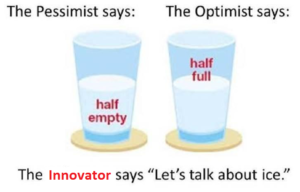 Half Full Half Empty or Talk About Ice
Half Full Half Empty or Talk About Ice
By Dave Whitney, Senior Consultant, Ascendian Healthcare Consulting
Twitter: @ascendian150
A wise man once said that the Optimist looks at the glass half full, the Pessimist looks at the glass half empty, and the Innovator says “let’s talk about ice”.
Creating value innovation within a healthcare organization can be incredibly challenging. Many organizations have undertaken innovation, strategy, and transformation initiatives with an attempt to increase quality while decreasing cost. Some organizations have been successful, while some have found it impossible to break the status quo. Although initiatives may be driven with best intent, aligning business units with shared interest and resources can stalemate execution. Ensuring that an initiative can be clearly defined by success criteria requires it must be fully vetted against business processes and modern technology. Therefore, Innovators look at not only the glass and water, but identify additional opportunities to enable success.
 From the outside a healthcare organization may appear driven by change and great intent. But on the inside, a battle for resources and prioritization wages on. Staging the smallest initiative requires heavy lifting and political warfare to tap into hyper-prioritized resources needed to create success. Many organizations are challenged to break the analysis barrier, let alone attempting strategy, execution, and iteration. All of these components require intimate knowledge of people, processes, and technology. Without a readily accessible resource pool, creating a rapid and successful transformation is both pointless and wasteful.
From the outside a healthcare organization may appear driven by change and great intent. But on the inside, a battle for resources and prioritization wages on. Staging the smallest initiative requires heavy lifting and political warfare to tap into hyper-prioritized resources needed to create success. Many organizations are challenged to break the analysis barrier, let alone attempting strategy, execution, and iteration. All of these components require intimate knowledge of people, processes, and technology. Without a readily accessible resource pool, creating a rapid and successful transformation is both pointless and wasteful.
This is where consultants enable innovation. Establishing a solid relationship with a consulting team steeped in subject matter expertise creates a cohesive layer between champions, initiatives, and resources. Let’s call it the glue which binds a successful transformation together. Deploying a consulting engagement can subsidize knowledge gaps by utilizing immediate and dedicated resources needed to drive success.
Assuming an organization has broken through the first stage and identified an opportunity for change. Let’s look at the overhead required to create a successful transformation initiative:
- First, consider the myriad of software vendors selling enterprise transformation across entire business segments.
- Now, consider how (and if) their products should fit within an enterprise transformation initiative.
- Finally, consider the resources required to research, recommend, plan and deploy the solution in accordance to success criteria.
And why are there a myriad of software products entering the market? The answer is that healthcare technology continues to expand across the patient continuum and deeper into business practices. This momentum is creating a highly stratified model of interconnectivity and integration. While providing opportunities for high-yield successes, the complexity of knowledge required to successfully deploy a solution may exceed the common healthcare organization’s available resources and skills. And, organizations may find it challenging to offset costs associated with acquiring additional FTE resources for an initiative driven project.
To advance an initiative with limited resources and minimal business continuity, consider how subject matter expert consulting services fit within the initiative. Consulting services not only provide seamless and highly-skilled resources needed to bridge the gap, but are utilized only during the time in which they are needed. These resources can be initiative driven, objective driven, or both. Additionally, a consultant resource can proactively drive initiatives and objectives to accelerate results on sizable investments. Choose wisely, however. The consultant must be able to quickly absorb, analyze, and produce results with great skills in navigating healthcare politics and communication. Partnering with a consultant maintaining incredible knowledge of people, processes, and technology is critical to a successful engagement. Choosing a consulting partner with a solid track record in transformation and innovation may very well be the most important decision in the transformation process. They must be subject matter experts in their field and thought leaders in the industry. Choose correctly, and a strong consultant team can efficiently guide organizations to break the status quo and achieve highly innovative and successful results.
About the Author: Dave Whitney is a Senior Consultant at Ascendian Healthcare Consulting and a frequent contributor to the subject of Health Information Technology. You may contact him directly at dwhitney@ascendian.com or visit the Ascendian website for more information at www.ascendian.com.
